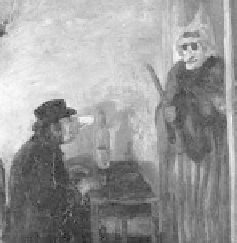Travel Reference
In-Depth Information
for exhibition. They were f latly
rejected.
The artist withdrew from pub-
lic view and, in seclusion, painted
Shocked Masks,
a dark and murky
scene set in a small room of an
ordinary couple wearing grotesque
masks. Once again, everyone dis-
liked this disturbing canvas and
heaped more criticism on him. For
the next six decades, Ensor painted
the world as he saw it—full of bizarre, carnival-masked, stupid-
looking crowds of cruel strangers who mock the viewer.
Jacques-Louis David (1748-1825)—
The Death of Marat
(1793)
In a scene ripped from the day's headlines, Marat—a well-known
crusading French journalist—has been stabbed to death in his
bathtub by Charlotte Corday, a con-
servative fanatic. Marat's life drains
out of him, turning the bathwater red.
With his last strength, he pens a final,
patriotic,
“Vive la Révolution”
message
to his fellow patriots. Corday, a young
noblewoman angered by Marat's cam-
paign to behead the French king, was
arrested and guillotined three days
later.
Jacques-Louis David, one of Marat's fellow revolutionaries,
set to work painting a tribute to his fallen comrade. (He signed
the painting:
“À Marat”
—“To Marat.”)
David makes it a secular
pietà,
with the brave writer as a
martyred Christ in a classic dangling-arm pose. Still, the deathly
pallor and harsh lighting pull no punches, creating in-your-face
realism.
David, the official art director of the French Revolution, super-
vised propaganda and the costumes worn for patriotic parades. A
year later (1794), his extreme brand of revolution (which included
guillotining thousands of supposed enemies) was squelched by
moderates, and David was jailed. He emerged again as Napoleon's
court painter. When Napoleon was exiled in 1815, so was David,
spending his last years in Brussels.
Paul Delvaux (1897-1994)
Delvaux, who studied, worked, and taught in Brussels, became
famous for his surrealistic paintings of nude women, often




















